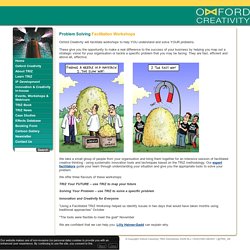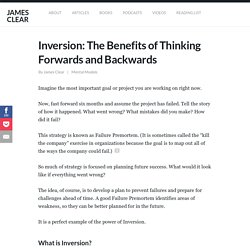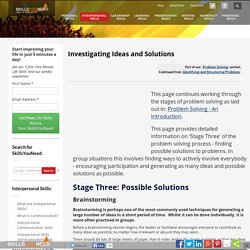

Oxford Creativity TRIZ Problem Solving Facilitation Workshops. Problem Solving Facilitation Workshops Oxford Creativity will facilitate workshops to help YOU understand and solve YOUR problems.

These give you the opportunity to make a real difference to the success of your business by helping you map out a strategic vision for your organisation or tackle a specific problem that you may be facing. They are fast, efficient and above all, effective. We take a small group of people from your organisation and bring them together for an intensive session of facilitated creative thinking - using systematic innovation tools and techniques based on the TRIZ methodology.
Our expert facilitators guide your team through understanding your situation and give you the appropriate tools to solve your problem. We offer three flavours of these workshops: Is a circle really finite? The Banach–Tarski Paradox. How to Solve Difficult Problems by Using the Inversion Technique. Imagine the most important goal or project you are working on right now.

Now, fast forward six months and assume the project has failed. Tell the story of how it happened. What went wrong? What mistakes did you make? How did it fail? This strategy is known as Failure Premortem. So much of strategy is focused on planning future success. The idea, of course, is to develop a plan to prevent failures and prepare for challenges ahead of time. It is a perfect example of the power of Inversion. What is Inversion? The way to use the Inversion Technique is to look at a particular problem from the opposite direction.
For example, if you want to be a better manager, then you would ask, “What would someone do each day if they were a terrible manager?” Carl Gustav Jacob Jacobi—who, in addition to growing up in a family that really valued the name Jacob, also was a fine mathematician—lived by the motto “man muss immer umkehren,” or loosely translated, “invert, always invert.” Becoming Smart vs. Sex. Problem Analysis & Problem Solving. The Art of Complex Problem Solving. Seven Step Problem Solving Technique. Seven Step Problem Solving Technique: what’s the problem?

Our seven step problem solving technique provides a structured basis to help deliver outcomes and solutions to your problems. If you are in hurry you can read our “manage in a minute” guide 7 Problem Solving Steps for the essentials of problem solving. Ever heard people say (or perhaps said yourself) things like : ” I wished we hadn’t jumped to that solution so quickly.” “I think we may have solved the wrong problem.” “It was only at the end that I realised we had acted too quickly with too little information.”
“The solution we went ahead with turned out to be impractical and too expensive.” Problem Solving Skills. Everybody can benefit from having good problem solving skills as we all encounter problems on a daily basis; some of these problems are obviously more severe or complex than others.

It would be wonderful to have the ability to solve all problems efficiently and in a timely fashion without difficulty, unfortunately there is no one way in which all problems can be solved. You will discover, as you read through our pages on problem solving, that the subject is complex. Problem Solving - Identifying & Structuring Problems. This page continues from Problem Solving an Introduction that introduces problem solving as a concept and outlines the stages used to successfully solve problems.

This page covers the first two stages in the problem solving process: Identifying the Problem and Structuring the Problem. Stage One: Identifying the Problem Before being able to confront a problem its existence needs to be identified. This might seem an obvious statement but, quite often, problems will have an impact for some time before they are recognised or brought to the attention of someone who can do anything about them.
In many organisations it is possible to set up formal systems of communication so that problems are reported early on, but inevitably these systems do not always work. Looking at the problem in terms of goals and barriers can offer an effective way of defining many problems and splitting bigger problems into more manageable sub-problems. Problem Solving, Investigating Ideas and Solutions. This page continues working through the stages of problem solving as laid out in: Problem Solving - An Introduction.

This page provides detailed information on 'Stage Three' of the problem solving process - finding possible solutions to problems. In group situations this involves finding ways to actively involve everybody - encouraging participation and generating as many ideas and possible solutions as possible. Brainstorming Brainstorming is perhaps one of the most commonly used techniques for generating a large number of ideas in a short period of time.
Whilst it can be done individually, it is more often practised in groups. Before a brainstorming session begins, the leader or facilitator encourages everyone to contribute as many ideas as possible, no matter how irrelevant or absurd they may seem. There should be lots of large sheets of paper, Post-It notes and/or flip charts available, so that any ideas generated can be written down in such a way that everyone present can see them. Problem Solving Activity. Problem Solving Activity: A Question Checklist to Investigate Problems This question checklist is a simple but effective problem solving activity.

It’s straighforward to use and easy to adapt to any specific circumstance. Using a set of structured questions encourages both broad and deep analysis of your situation or problem. The questions themselves may be simple, but when used as part of the checklist, they become a powerful management tool. This tool uses a question hierarchy (see our article Best Management Tool Ever?
In this hierarchy, “what” broadly states the situation or problem although “why” is arguably the most powerful question you can ask. It can be especially valuable when applied as part of the well known problem solving technique, 5 Whys. Next you should use “how”, “where”, “who” and “when”. When combined into a question checklist, they become both a tool for analysing and solving problems, and the basis for an action plan.
Problem Solving Techniques. The Art of Complex Problem Solving. Problem Solving.